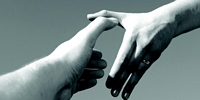The sciatic nerve is located deep in the muscles of the buttocks, originating from the sacral plexus and running distally along the thigh with its branches to the shank and foot. It is an important nerve of the lower extremities, for both motor and sensory purposes.
Sciatica is a painful inflammation of the sciatic nerve, usually neuritis, but it may also result from pressure by tumor or inflammation of the neighboring bones, tendons or muscles, particularly by protruding intervertebral disc. In an acute case of protrusion of intervertebral disc, there is a cutting pain that radiates from the iliacsacral region to the foot, causing an inability to walk. When it becomes chronic, the patient will feel a dull stretching pain and have difficulty walking.
To determine the cause is the most important thing in the treatment of sciatica. If the pain is caused by pressure from outside the nerve, the pressure should be relieved. If sciatica is the result of an inflammation, bed rest, analgesics, acupuncture and massage therapy are indicated. In chronic cases, the following system of physical therapy is advised.
There is a saying in China: "A door-hinge is never worm-eaten." It means that appropriate motion can prevent strain. Therefore, a sciatica patient should not keep motionless for fear of pain. Keeping motionless will aggravate the symptoms.
In chronic cases of sciatic neuritis, the pain is associated with adhesion around the nerve. "Lying, sitting and standing" is a great treatment for this condition, providing an opportunity to exercise the sciatic nerve by tightening and relaxing it and helping relieve adhesion and alleviate pain after repeated practice.
Instructions
1. Lying: Lie supine in the bed with the legs bent. Without letting the feet leave the surface of the bed, straighten the legs one after the other. While they are stretched straight, lift the legs above the bed alternately. Lift the healthy leg to an angle of 90 degrees and the affected leg to an angle of 45 degrees at first. By practicing, the affected leg can be gradually lifted higher to form a perpendicular angle as well (see Fig. 1).
2. Sitting: Sit upright on a mat or on the floor with the legs straight in front, the feet flexed so that the heels touch the ground and the hands placed fiat on the



